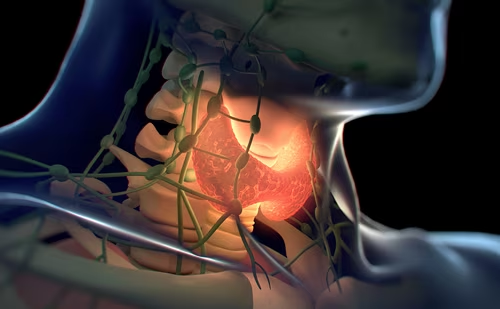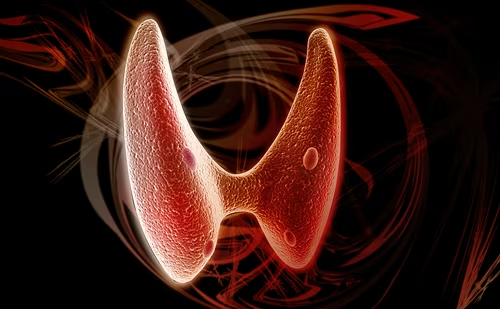Subclinical hypothyroidism (SCH) is defined as an above normal serum thyroid-stimulating hormone (TSH) level with normal free thyroxine (FT4) and free triiodothyronine (FT3) levels. The overall prevalence of the disease is 4–15%, and it is more common in women, the elderly, and those with a positive family history for thyroid disease.
Subclinical hypothyroidism (SCH) is defined as an above normal serum thyroid-stimulating hormone (TSH) level with normal free thyroxine (FT4) and free triiodothyronine (FT3) levels. The overall prevalence of the disease is 4–15%, and it is more common in women, the elderly, and those with a positive family history for thyroid disease. The most common cause is autoimmune thyroiditis (also known as Hashimoto’s thyroiditis), which is often accompanied by raised levels of antithyroperoxidase (TPO) antibodies.1 During the last decade, there has been a plethora of reports and reviews on the clinical relevance and management of subclinical thyroid dysfunction, including position papers, guidelines, and debates about screening and outcomes.
To develop an evidence-based approach to many unresolved issues regarding subclinical thyroid disease, the American Association of Clinical Endocrinologists (AACE), the American Thyroid Association (ATA), and the Endocrine Society (TES) sponsored a consensus development conference held in 2002, the conclusions and recommendations of which were published in 2004.2
Subsequently, the leadership of the three societies “determined that it would not be appropriate for practicing clinicians and regulatory elements of the health industry to be left with the impression that the membership of these three organizations unanimously agreed with all the consensus conference recommendations.”3 Accordingly, they convened a task force to review and reply to the recommendations of the consensus panel. While the task force agreed with many of the recommendations of the consensus panel, there was significant disagreement in several major areas. For example, in contrast to the consensus panel, the task force suggested the following:
- routine TSH screening in the general population;
- routine TSH screening in pregnant women or those planning pregnancy;
- that there is fair evidence favoring the treatment of SCH and poor evidence as to the risks of treatment; and
- routine treatment of patients with serum TSH levels of 4.5–10mIU/l.
This article presupposes that SCH is equivalent to an early or mild hypothyroidism warranting thyroxine (T4) replacement therapy. Moreover, it will provide evidence in support of a narrower TSH reference range, give new data on adverse clinical effects of SCH, discuss the potential benefits of T4 therapy, and try to illustrate that the early detection and treatment of SCH outweighs the potential side effects.
What Is a Normal Thyroid-stimulating Hormone Level?
The current TSH reference range is 0.5–5mIU/l. It should be noted that reference ranges are not synonymous with ‘normal’ ranges. Reference ranges are derived from cross-sectional population studies without detailed knowledge of underlying or occult thyroid disease. Recent data suggest that the current TSH reference range may not reflect the true normal range for TSH, which probably has a narrower range of 0.4–2.5 or 3mIU/l.4
Introduced into clinical practice in the late 1960s, the first-generation TSH radioimmunoassays had a ‘normal’ range of about 4–10mIU/l. It was inevitable that with advancing technology and the new immunometric assays, more sensitive TSH assays would have a lower/narrower reference range of 0.5–5mIU/l in most laboratory reports. Currently, most laboratories report these values as representing the ‘normal’ TSH range. The National Health and Nutrition Examination Survey (NHANES)-III study screened 17,353 subjects, excluding those with possible thyroid disease, those who were pregnant, or patients taking thyroid hormones, androgens, or estrogens. In the remaining ‘normal’ population of 13,344, 95% had a TSH range of between 0.3 and 2.5mIU/l (see Figure 1). The report suggested ethnic differences should be considered when establishing normal TSH ranges. For example, the mean TSH level was 1.18 and 1.40mIU/l in African-Americans and Caucasians, respectively.5
The National Academy of Clinical Biochemistry (NACB) has suggested that the ‘normal’ TSH range should be between 0.4 and 2.5mIU/l.6,7 A recent report from Germany agrees with this, showing that in a group of 1,488 subjects with neither clinical nor sonographic evidence of thyroid disease, the 2.5th to 97.5th percentile for serum TSH was 0.25–2.12mIU/l lower than reference ranges.8 In another study, the TSH range in a small group of normal men studied daily for one year had a narrow range of 0.16–2.4mIU/l, with the mean being around 1.27.9 Of note, the narrow individual range changes very little unless hypo- or hyperthyroidism develops. These reports, along with expert opinion,4,10 collectively support the concept that the ‘normal’ TSH range should be narrower, with a TSH upper limit of 2.5 or 3mIU/l.
The presence of TPO antibodies is highly suggestive of an underlying autoimmune disease.1,4 In the NHANES-III report, 80–90% of subjects with a TSH >10mIU/l tested positive for TPO. Moreover, a significant increase in TPO titers occurred at TSH levels of ≥2mIU/l. This supports the argument that TSH values >2.5 are “predictive of evolution into hypothyroidism.” Approximately 2–5% of those with SCH will progress to overt clinical disease, the rate being higher when both TSH and TPO are elevated (see Table 1).11
Hyperlipidemia and Cardiovascular Disease
Hyperlipidemia and cardiovascular disease (CVD) are known complications of clinical hypothyroidism, and recent reports also link hyperlipidemia and early CVD to SCH. Caraccio et al. reported a significant increase in total cholesterol (TC) and low-density lipoprotein cholesterol (LDL-C) in SCH patients compared with controls, a finding confirmed by others.12 A recent literature review by Duntas and Wartofsky concluded that “hypercholesterolemia and, more specifically, the elevated TC/highdensity lipoprotein cholesterol (HDL-C) and LDL-C/HDL-C ratios that are often observed in SCH constitute risk factors for CVD that are probably increased by the co-existence of hypertension, being overweight, or having insulin resistance.”13 In this analysis, it appeared that hyperlipidemia was more severe in patients with higher TSH levels or those who had elevated LDL-C at baseline.
The data on the risk for CVD in SCH are conflicting, although most suggest some degree of CVD in SCH. Biondi et al. have shown that SCH may be associated with left ventricular diastolic and systolic dysfunction.14,15 Imaizumi and colleagues studied 257 patients with SCH and reported an increased 10-year mortality rate in men but not women compared with a large group of euthyroid subjects.16 In this study, SCH was associated with ischemic heart disease independent of age, blood pressure, smoking, or body mass index (BMI). Recently, Iervasi et al. reported that among 208 SCH patients with TSH levels of between 4.5 and 10mIU/l, deaths occurred in 13% compared with 7% of euthyroid cardiac patients.17 The problem with individual reports is the low number of patients studied, which sometimes precludes definitive conclusions. Recently, Rodondi et al. pooled data from 14 observational studies and performed a meta-analysis of 1,362 coronary heart disease outcomes and 10,540 subjects.18 This study showed that SCH significantly increased the risk for CHD, with a summary odds ratio of 1.65 (95% confidence interval [CI] 1.28–2.12), but did not elucidate the mechanisms by which SCH may increase CHD risk. The authors proposed “clinical trials to assess whether T4 replacement reduces the risk for CHD with SCH.”
The Results of Thyroxine Therapy
Emerging evidence supports the theory that lipid and cardiac abnormalities improve with T4 treatment. T4 therapy improves diastolic function, exerts a positive effect on systolic function, and increases ejection fraction. In a randomized, placebo-controlled study of 45 patients with SCH, Monzani et al. showed that T4 therapy for six months reduces serum TC, LDL-C, serum TSH, and mean intima-media thickness.19 The latter was measured in carotid arteries by ultrasound examination representing atherogenesis. In another prospective study, T4 therapy improved endothelial dysfunction measured by vasodilatation.20 Further support of a beneficial effect of T4 on cardiovascular risk factors and quality of life in SCH was recently provided by Razvi et al.21 In this randomized cross-over trial, the largest of its kind so far, the authors showed that 50 patients with SCH treated with T4 had a significant improvement in CV risk factors and symptoms of tiredness. They used brachial artery flow-mediated dilatation (FMD) as a surrogate marker for coronary artery disease and used validated instruments to assess patient-reported outcomes. T4 therapy reduced TC and LDL-C by 5.5 and 7.3%, respectively, with an inverse correlation between risk reduction and FT4 levels. The study confirmed the beneficial effect of T4 on FMD in patients with SCH, independent of other CV risk factors.
The Issues of Screening
Although the consensus panel found “insufficient evidence to support population-based screening,” the task force felt that as long as data are “insufficient to recommend for or against routine screening for thyroid in adults,” based on expert opinion, screening is appropriate. Population major professional societies have endorsed routine TSH screening (see Table 2).
Furthermore, while the consensus panel recommended against routine screening in pregnancy, preferring “aggressive case-finding,” the task force believed that routine TSH testing for thyroid disease in pregnant women or those planning pregnancy is justified considering the relatively high frequency of SCH in this population, as well as the potential serious damage to the fetus caused by even slight TSH elevations.23 In fact, this recommendation appeared to be consistent with a previous position paper in which the AACE endorsed routine thyroid testing in pregnancy, leaving the specifics of management “to the judgment of the physician in consultation with the patient.”24
Conclusions
What should the primary care physician or the endocrinologist do? It is certainly unreasonable to believe that no patient with a serum TSH 5–10mIU/l should be treated. In deciding to treat or not, one must remember that SCH, defined by a minimal TSH elevation of between 5 and 10mIU/l, is mild hypothyroidism and, accordingly, is expected to have mild symptoms and side effects. Treatment rather than observation is favored because some studies do show improvements in outcomes such as lipids and cardiac function, T4 therapy is low-risk and low-cost, and treatment will prevent the development of overt hypothyroidism, which occurs at about 3–5% per year in SCH. Obviously, initial serum TSH elevation must be confirmed, and the decision to treat should take into account the individual clinical context (see Table ), not just a single laboratory value. One should also bear in mind that a “lack of definitive evidence for a benefit does not equate to evidence for a lack of benefit.”3
Until more data are available, a common-sense approach would seem to be to:
- treat all patients with serum TSH >10mIU/l;
- treat most patients with serum TSH 5–10mIU/l provided that TSH elevation is confirmed, especially if TPO is positive or other risk factors/conditions are present (see Table 3);
- screen all pregnant women or those planning pregnancy with TSH (followed by FT4 if TSH is abnormal);
- treat those with mildly elevated TSH values; and
- for T4 replacement therapy, consider a target TSH of 0.5–3mIU/l.
■







